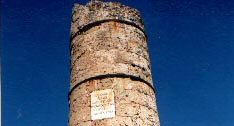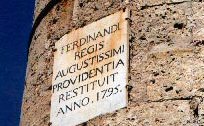
The Villa Romana del Tellaro Noto Antica Eloro The Sanctuaries Castelluccio Vendicari
 Leaving the town centre and following the way to the city
graveyard, we turn on the right and next to the left
on the way to C/da Zupparda. We pass the Noto-Pachino crossign,
after few meters we turn on the right, following the way till
the fork. We turn again to the right and after about a thousand
of meters we can see, on the left, the Pizzuta Pillar or Piliere,
which was part of the funeral area of the Eloro town. This pillar
has an almost cylindrical shape, it is ten meters tall and is
built upon a step basement. They also found a funeral couch and an
armchair, completely excaved in the stone, a mirror and some
coins depicting king Ierone II. By means of these elements we
can place the sepulchre in the Ellenistic Age (III century B.C.).
Few kilometers away, following the signals, we arrive to Eloro,
which arises on a short hill, bounded to the est from the Ionio sea,
and to the south from the Eloro river (Tellaro).
Leaving the town centre and following the way to the city
graveyard, we turn on the right and next to the left
on the way to C/da Zupparda. We pass the Noto-Pachino crossign,
after few meters we turn on the right, following the way till
the fork. We turn again to the right and after about a thousand
of meters we can see, on the left, the Pizzuta Pillar or Piliere,
which was part of the funeral area of the Eloro town. This pillar
has an almost cylindrical shape, it is ten meters tall and is
built upon a step basement. They also found a funeral couch and an
armchair, completely excaved in the stone, a mirror and some
coins depicting king Ierone II. By means of these elements we
can place the sepulchre in the Ellenistic Age (III century B.C.).
Few kilometers away, following the signals, we arrive to Eloro,
which arises on a short hill, bounded to the est from the Ionio sea,
and to the south from the Eloro river (Tellaro).
 About 700 years before Christm, the Siracusan Corintians built
a small military town, next endowed with a powerful boundary wall
in the VI century B.C. They also built a Sanctuary dedicated to
Demetra and Kore, also called Koreion, built outside the wall
(VI century B.C.). This sanctuary has been partially rebuilt
in the Civic Museum. Next they had an Asklepeion dedicated
to Esculapio with a Thesaurós (IV century B.C.), a
temple dedicated to Demetra (III century B.C.), a
small greek theatre (IV century B.C.) partly excaved in the
hill, to the south, and partly a brickwork. In the II century
B.C. Eloro was endowed with a stoà/porticus of Doric style.
In the south-weastern corner of the hurban zone, was
build (in greek age) a fortress (the Castellum), named by Plinio
il Vecchio (I century A.C.). In 1353, Count Blasco
Alagona had sighting tower built on this site.
About 700 years before Christm, the Siracusan Corintians built
a small military town, next endowed with a powerful boundary wall
in the VI century B.C. They also built a Sanctuary dedicated to
Demetra and Kore, also called Koreion, built outside the wall
(VI century B.C.). This sanctuary has been partially rebuilt
in the Civic Museum. Next they had an Asklepeion dedicated
to Esculapio with a Thesaurós (IV century B.C.), a
temple dedicated to Demetra (III century B.C.), a
small greek theatre (IV century B.C.) partly excaved in the
hill, to the south, and partly a brickwork. In the II century
B.C. Eloro was endowed with a stoà/porticus of Doric style.
In the south-weastern corner of the hurban zone, was
build (in greek age) a fortress (the Castellum), named by Plinio
il Vecchio (I century A.C.). In 1353, Count Blasco
Alagona had sighting tower built on this site.
The agorà (square) of Eloro, political and trading centre, was crossed by the main way which brought the traveller in the Via Elorina to Siracusa.
made by Antonino Parisi